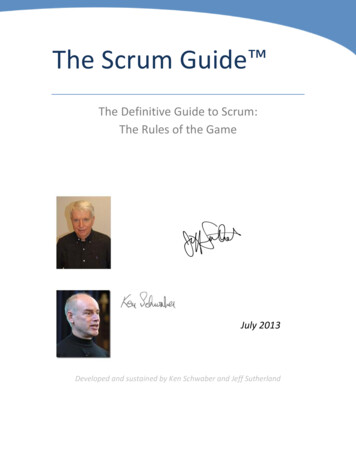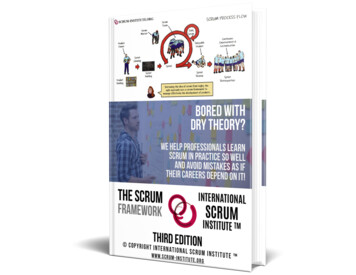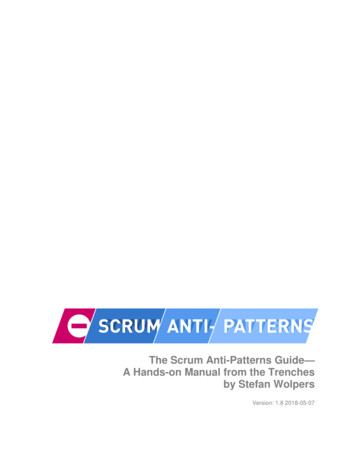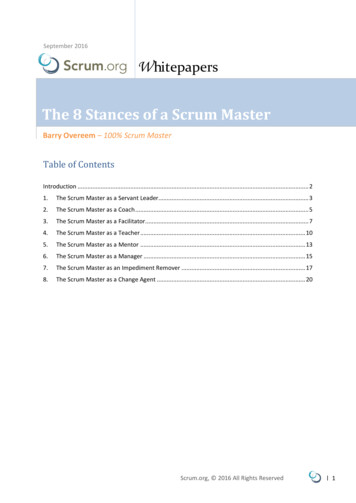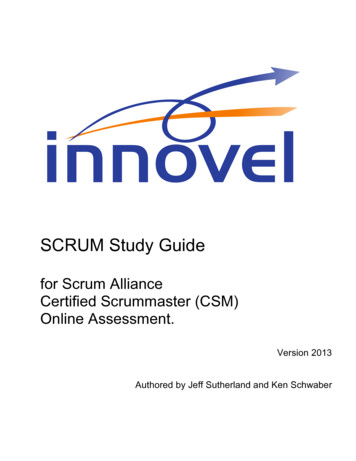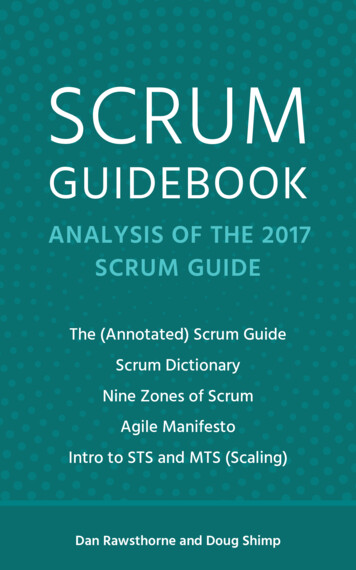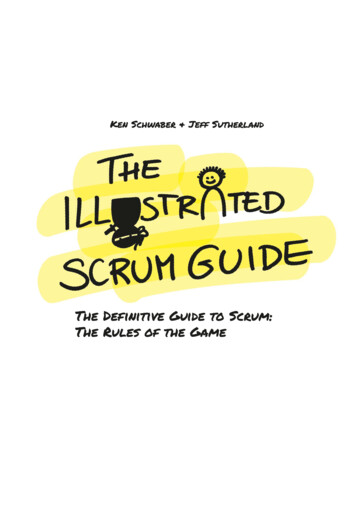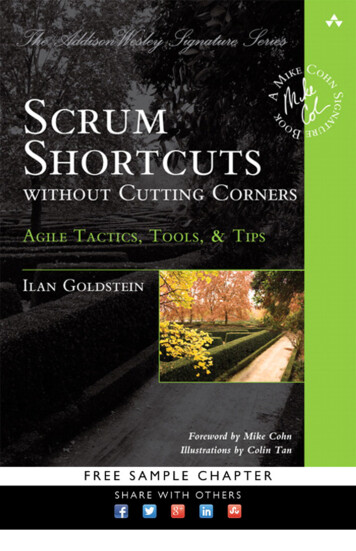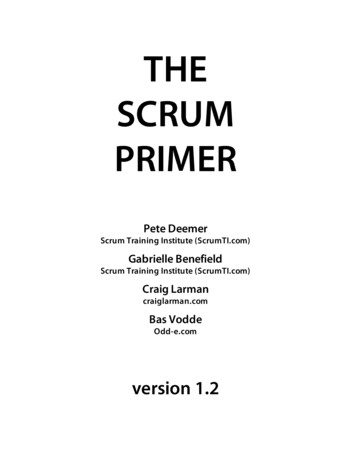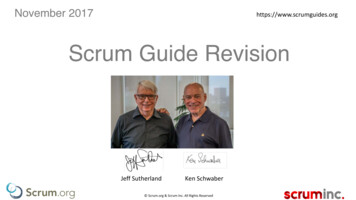
Transcription
November 2017https://www.scrumguides.orgScrum Guide RevisionJeff SutherlandKen Schwaber Scrum.org & Scrum Inc. All Rights Reserved
Introductionhttps://www.scrumguides.org Scrum.org & Scrum Inc. All Rights Reserved
Agendahttps://www.scrumguides.org How we have gotten here What has changed in the Scrum Guide Addressing common misconceptions Scrum.org & Scrum Inc. All Rights Reserved
https://www.scrumguides.orgA Little About Scrum Scrum.org & Scrum Inc. All Rights Reserved
https://www.scrumguides.orgScrum is Everywhere90% 12MEstimated Agile Teams Use ScrumEstimated Using Scrum DailyPracticed everywhereOne Scrum Guide Scrum.org & Scrum Inc. All Rights Reserved
Brief History of ScrumWhy Realization that simpleindustrial techniques wereinadequate We needed an approach thataddressed complex work A desire for iterative,incremental cycles to supportempirical inspection andadaptation– To maximize appliedintelligence– Small, cross-functional, selfmanaging teamshttps://www.scrumguides.orgHowWhat Confluence of ideasbetween LeanThinking andEmpirical Processcontrol Scrum is a simpleframework When applied,process emerges For Scrum to work, weneeded the emergence fessionalism Art of the possible Learn early, learn often Scrum.org & Scrum Inc. All Rights Reserved
The Essence of Scrumhttps://www.scrumguides.org The essence of Scrum is a small team of people The individual team is highly flexible and adaptive Scrum’s strengths operate whether– In a single team– Across many teams– Between networks of teams Teams develop, release, operate and sustain thework and work products of thousands of people They collaborate and interoperate throughsophisticated development architectures and targetrelease environments Scrum.org & Scrum Inc. All Rights Reserved
Scrum Is Needed More Than Everhttps://www.scrumguides.orgChallenges are moving beyond the complex, increasingly to the chaotic. The rate ofchange is well beyond linear.Three dimensions of change: People – markets, increased number, distribution, social organization, religion Technology – iPhone in 2007, robust Internet, energy Mother Earth – things are changing“In a world rife with change, dominance is fleeting; only agility createssustainable advantage. As we move forward, the market must put a premium onagility and companies must measure it along with other key metrics.”Making Business Agility a Key Corporate Attribute – Forbes.com http://bit.ly/2gqkpgn Scrum.org & Scrum Inc. All Rights Reserved
Scrum Improves How We Workhttps://www.scrumguides.orgHelps contain riskCreates value using the “art of the possible”Absorbs and learns from failureCan operate at the edge of chaos, with Product Owners (scientists, researchers,visionaries) bringing opportunity to complex mechanisms of Scrum Scrum Masters are skilled change agents – We recommend establishing new organizations– Changing people under stress from the three vectors is often fruitless; also what is thepattern of from-to– Scrum Teams are experienced at complex change Scrum.org & Scrum Inc. All Rights Reserved
https://www.scrumguides.orgThe Scrum Guide Scrum was formally presented by Scrum co-creators KenSchwaber and Jeff Sutherland in 1995 at the OOPSLAConference in Austin, Texas The first version of the Scrum Guide was released in 2010as the official Body of Knowledge of Scrum Ken and Jeff are the owners and mentors of Scrumthrough the Scrum Guide, in continuation of its creation,sustenance, and enhancements over the years Through inspection and adaption, they have releasedupdates in 2011, 2013 and 2016 based on:– Their experience working with organizations around the world– Feedback from Scrum practitioners via the Scrum Guides UserVoice Scrum.org & Scrum Inc. All Rights Reserved
https://www.scrumguides.orgThe Scrum Guide 2017 Scrum.org & Scrum Inc. All Rights Reserved
Overview of What is Newhttps://www.scrumguides.orgThis release focuses on responses to input from Scrum users Uses of Scrum Refined the Role of the Scrum Master The Daily Scrum is for Inspection and Adaptionto ensure progress toward the Sprint Goal Time-boxes carry a maximum length– “Time-boxing refers to the act of putting strict timeboundaries around an action or activity” Sprint Backlog includes feedback from theSprint Retrospective Scrum.org & Scrum Inc. All Rights Reserved
Uses of Scrumhttps://www.scrumguides.orgScrum has been used extensively, worldwide, to: Research and identify viable markets, technologies, andproduct capabilities Develop products and enhancements Release products and enhancements, as frequently asmany times per day Develop and sustain Cloud (online, secure, on-demand)and other operational environments for product use Sustain and renew products Scrum.org & Scrum Inc. All Rights Reserved
The Role of the Scrum MasterThe Scrum Master is responsible for promotingand supporting Scrum as defined in the ScrumGuide. Scrum Masters do this by helpingeveryone understand Scrum theory, practices,rules, and values.And as possible within the culture of the organizationand within the Scrum Master’s organizational andpolitical skills, and patience. Scrum.org & Scrum Inc. All Rights Reservedhttps://www.scrumguides.org
The Daily Scrumhttps://www.scrumguides.orgThe Daily Scrum is for Inspection and Adaption to ensure progress is being madetoward the Sprint GoalThe Development Team uses the Daily Scrum to inspect progress toward theSprint Goal and to inspect how progress is trending toward completing the work inthe Sprint Backlog. The Daily Scrum optimizes the probability that theDevelopment Team will meet the Sprint Goal. Every day, the Development Teamshould understand how it intends to work together as a self-organizing team toaccomplish the Sprint Goal and create the anticipated Increment by the end of theSprint.The structure of the meeting is set by the Development Team and can beconducted in different ways if it focuses on progress toward the Sprint Goal. SomeDevelopment Teams will use questions, some will be more discussion based. Scrum.org & Scrum Inc. All Rights Reserved
Time-Boxes Only Require a Maximum Lengthhttps://www.scrumguides.orgAdded clarity around time-boxes using the words “at most” to removeany questions that Events have to be of a certain length. Time-boxesare the maximum times allotted.“Time-boxing refersto the act of puttingstrict time boundariesaround an action oractivity” Scrum.org & Scrum Inc. All Rights Reserved
Continuously Improve How the Team Workshttps://www.scrumguides.orgThe Sprint Backlog makes visible all the work that the DevelopmentTeam identifies as necessary to meet the Sprint Goal. To ensurecontinuous improvement, it includes at least one high priority processimprovement identified in the previous Retrospective meeting. Scrum.org & Scrum Inc. All Rights Reserved
https://www.scrumguides.orgAddressing common misconceptions Scrum.org & Scrum Inc. All Rights Reserved
Is Scrum Only Relevant to Software Delivery?https://www.scrumguides.orgWe build useful products; software is only part of the equation.How often the team is able to release, and how the product is supported are often part ofthe equation, but so is the customer’s ability to absorb the new functionality.Example: Self-driving cars where more functionality is released than is within theboundaries of safety.Product Development includes Product Backlog dimensions for: DevelopmentBug fixing and technical debt remediationOperational environment developmentOperational environment stagingMarketingSupport preparation, training and readinessHelp and support files preparation and testingPilot markets and early releasesEverything else needed to realize value, such as partnerships Scrum.org & Scrum Inc. All Rights Reserved
Can I Release Before the End of the Sprint?https://www.scrumguides.org Releases may be delivered at any time that the Product Owner chooses and theScrum Team is capable of– Watch out for value being outweighed by debt The only requirement is that at the end of the Sprint there is an increment that is“Done” and must be in useable condition regardless of whether the ProductOwner decides to actually release it The practices of continuous delivery can be used with Scrum Scrum.org & Scrum Inc. All Rights Reserved
What about DevOps?https://www.scrumguides.org The Development Team has to prove within the first several Sprints that theProduct is viable and will produce value To do this, they need an operational environment and initial architecture whereinthe service level agreement goals are being met If the Scrum Team is empowered and the organization is supportive, the result isorganizational change without any crisis Scrum projects often require new capabilities to be instantiated and tested priorto proceeding– Minimize risk early Scrum.org & Scrum Inc. All Rights Reserved
What’s Nexthttps://www.scrumguides.org The Scrum Guide is available now - http://www.scrumguides.org/ 30 translations in progress Visit the UserVoice and let us know what you thinkhttps://scrumguide.uservoice.com/ Scrum.org & Scrum Inc. All Rights Reserved
Scrum was formally presented by Scrum co-creators Ken Schwaber and Jeff Sutherland in 1995 at the OOPSLA Conference in Austin, Texas The first version of the Scrum Guide was released in 2010 as the official Body of Knowledge of Scrum Ken and
